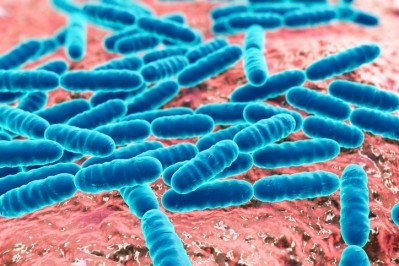Producer makes the case for enzymes in shift away from AGPs
![The addition of xylanase to wheat base diets decreased digesta viscosity and fermentation, increased nutrient digestion and digesta passage, and reduced the amount of nutrients available to the microflora: study [pic: (c) istock.com Sage78]](/var/wrbm_gb_food_pharma/storage/images/_aliases/wrbm_large/1/1/9/3/1423911-1-eng-GB/Producer-makes-the-case-for-enzymes-in-shift-away-from-AGPs.jpg)
“When industry talks about potential alternatives or about reducing the need for antibiotics, the conversation typically turns to probiotics, microbials and other options - there has been little discussion of how feed enzymes, animal nutrition and gut health can be used as an effective way to mitigate the ill effects of pathogenic bacteria.
However, certain enzymes may be used to achieve the same effect as antibiotics, albeit through a different mechanism,” said Dr Giles Shih, CEO of BRI, a global biotechnology company specializing in the research, development and manufacture of enzyme feed additives.
And he told us a body of research into the influence of enzymes on poultry and swine production and how such additives can help minimize antibiotic use has been built up over the past five to ten years.
Challenge tests
BRI, he said, is in the process of setting up pathogenic bacteria challenge trials with some of its enzyme products with Southern Poultry Research in Georgia in the US.
Such testing is aimed at trying to get a deeper understanding of the mode of action of its enzymes in terms of this kind of functionality, said Shih.
He said enzymes can boost animal health through improving feed ingredient digestibility in the animal’s foregut, allowing better nutrient absorption and minimized nutrients available for pathogenic microbes in the colon.
They can also break down anti-nutritional factors associated with gut inflammation, he added.
There is also a prebiotic effect from using xylanases, for example, in pig and poultry feed as they release xylo-oligosaccharides that can have a positive influence on intestinal bacteria, supporting the proliferation of beneficial microflora, said Shih.
“And genomic tools are now more readily available to assist researchers in gaining better insights into the microbiome, to discern between poor and good gut health and to examine the impact of the supplementation of enzymes by measuring intestinal villus height,” he said.
Freedonia values the global feed enzyme sector in the range of US$750 to $800 million globally.
And MarketandMarkets recently forecast the category will reach $1,371.03m in value by 2020, at a compound annual growth rate (CAGR) of 7.3% from 2015 to 2020.
Globally the big players include AB Enzymes, Adisseo, BASF, DSM, DuPont, and Novozymes, according to Freedonia.
Decreasing digesta viscosity
Australian based researchers, in a paper1 on alternatives to in feed antibiotics published in Animal Nutrition in March this year, said modification of diet and the addition of enzymes cannot provide total protection against necrotic enteritis (NE) in poultry, but may reduce the risk of NE by improving digestion.
“For example, dietary cereals such as barley, rye and wheat contain high amounts of arabinoxylans or β glucans, mannans, cellulose, lignin and ingredients, which cannot be digested by poultry. These non-digestible feed constituents increase the digesta viscosity and encourage the development of NE (Dahiya et al., 2006 and McDevitt et al., 2006).
Also, poultry diets with high protein content, or those rich in animal protein such as meat and bone meal or fish meal predispose birds to NE (Kaldhusdal and Skjerve, 1996, Williams et al., 2003, Williams, 2005, Wu et al., 2010 and Wu et al., 2014).
Thus, reducing indigestible carbohydrates and proteins that predispose birds to NE may decrease the risk of NE outbreak in poultry farms
It has been demonstrated that inclusion of exogenous enzymes to wheat, barley, oat or rye based diets can significantly decrease digesta viscosity in the small intestine (Bedford and Classen, 1992 and Choct et al., 1999).
Choct et al. (1999) reported that the addition of xylanase to wheat base diets decreased digesta viscosity and fermentation, increased nutrient digestion and digesta passage, and reduced the amount of nutrients available to the microflora, which, in turn, may reduce the bacterial population in the small intestine.”
But the Australian team said further research is needed to investigate the effect of feed enzymes on the incidence of NE, so as to clarify the role of the enzymes in the possible control of the disease.
Studies on xylanase and protease
Shih said a collaborative study between North Carolina State University and BRI published in July suggested adding xylanase — 1,400 U of enzyme/kg feed — to corn-soybean meal-based pig diets enhanced growth performance and gut health of nursery pigs as shown by improved feed efficiency, reduced malondialdehyde (MDA) and reduced tumor necrosis factor-α (TNF-α) concentrations in duodenal mucosa.
While the results of another research project BRI carried out with the same institution, released back in March, indicated its broad spectrum protease feed enzyme, Versazyme, improved feed efficiency and gut health, and increased growth performance of newly weaned pigs fed diets with different levels of soybean meal (SBM), he said.
That team concluded: “Collectively, dietary supplementation of protease enhanced feed efficiency and gut health as measured by deceased TNF-a and increased villus height.”
1Source: Animal Nutrition
Title: Towards the control of necrotic enteritis in broiler chickens with in-feed antibiotics phasing-out worldwide
DOI: doi:10.1016/j.aninu.2015.02.004
Authors: S. A. M’Sadeq, S. Wu, R. A. Swick, M. Choct













